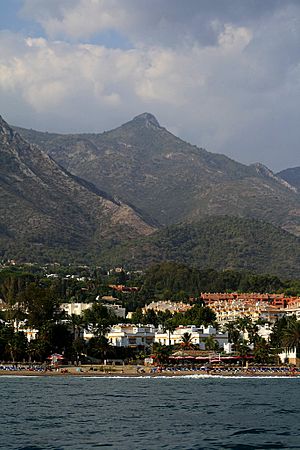Marbella blast furnaces facts for kids

The Marbella blast furnaces (also known as altos hornos de Marbella in Spanish) were very important iron factories in Spain. They were actually the second ones ever built in the country!
These large furnaces were built in Marbella because of some important discoveries. People found lots of iron ore (rock with iron in it) nearby in Ojén. There was also plenty of charcoal from the trees in the Sierra Blanca mountains. Plus, the Verde River provided all the water needed. All these things were crucial for making iron.
In 1826, two companies started up: La Concepción and El Angel. Manuel Agustín Heredia started La Concepción. For a while, these furnaces made 75% of all the iron in Spain! However, making iron with charcoal was much more expensive than using a fuel called coke. Because of this, the iron industry in Marbella eventually closed down. It couldn't compete with factories in the north of Spain that used cheaper methods.
Contents
The History of Iron Making in Marbella
Early Iron Production
In 1828, a businessman from Málaga named Manuel Heredia started a company called La Concepción. His goal was to dig up the iron ore found in the Sierra Blanca mountains near Ojén. He chose this spot because there was lots of charcoal from the mountain trees. Also, the Verde River provided a steady supply of water. Both charcoal and water were essential for making iron.
In 1832, La Concepción built Spain's first charcoal-fired blast furnace for non-military use. By around 1840, the iron factories in the province of Málaga were producing a huge amount of iron. They made up to 75% of all the cast iron in Spain! La Concepción and La Constancia were the biggest iron companies in the area.
Changes and Challenges
In 1860, the Marqués del Duero started a farming community. This area is now the center of San Pedro de Alcántara. Around the same time, the iron factories of El Angel and La Concepción began to close down. This was a big problem for the local people. Many had to go back to farming or fishing to earn a living.
Life became even harder because traditional farming faced many problems. There was also a disease called phylloxera blight that destroyed vineyards. All these issues led to high unemployment, more poverty, and many day laborers going hungry in Marbella.
A Brief Comeback
In 1871, a British company called the Marbella Iron Ore Company built new facilities for the El Angel factory. This helped the situation for a while. Marbella even became a place where people moved to find work, and its population grew. However, this company didn't last. It closed in 1893 because of a worldwide economic crisis. The company also found it hard to sell the iron ore it dug from its mine.
See also
- In Spanish: Altos hornos de Marbella para niños


